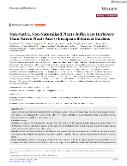Non-Native, Non-Naturalised Plants Suffer Less Herbivory Than Native Plants Across European Botanical Gardens

Autor
Ivison, Katy
van Kleunen, Mark
Speed, James David Mervyn
Vange, Vibekke
Pujara, Sonia
Boch, Steffen
Enters, Dirk
Groom, Quentin
Jeschke, Jonathan M.
Joshi, Jasmin
Kolb, Annette
Kollmann, Johannes
Lemke, Tristan
Matthies, Diethart
Raabová, Jana
Tielbörger, Katja
Dawson, Wayne
Datum vydání
2024Publikováno v
Diversity and DistributionsRočník / Číslo vydání
30 (12)ISBN / ISSN
ISSN: 1366-9516ISBN / ISSN
eISSN: 1472-4642Metadata
Zobrazit celý záznamKolekce
Tato publikace má vydavatelskou verzi s DOI 10.1111/ddi.13938
Abstrakt
AIM: The enemy release hypothesis states that the invasion success of non-native species is partly due to their escape from natural enemies, e.g., herbivores. Large-scale studies of herbivory using multiple species across multiple sites are needed to test the generality of herbivory release in non-native plants.Location: Europe.METHODS: We carried out leaf-herbivory surveys from 2007 to 2021 in 15 botanical gardens ranging in latitude from 47°N (Switzerland) to 63°N (Norway) to investigate how herbivory levels differed between (i) native and non-native species, and (ii) native and non-naturalised or naturalised species.RESULTS: Overall, we found that herbivory levels were lower on non-native than native species. In addition, we found that non-naturalised plants suffered less herbivory than natives and that naturalised plants showed similar levels of herbivory to native plants.MAIN CONCLUSIONS: We find broad support for lower herbivory of non-native plant species compared to natives. However, the stronger reduction in herbivory for non-naturalised plants suggests that herbivore release may be transient and less pronounced for naturalised non-native species that have become abundant and integrated into resident communities. This has implications for the management of naturalised non-native plants, which are performing well in their non-native ranges despite suffering comparable herbivory levels to native species.
Klíčová slova
botanic gardens, enemy release, Europe, herbivory, latitudinal gradient, naturalisation, non-native species
Trvalý odkaz
https://hdl.handle.net/20.500.14178/2884Licence
Licence pro užití plného textu výsledku: Creative Commons Uveďte původ 4.0 International






